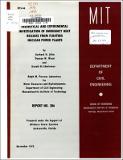| dc.contributor.author | Jirka, Gerhard H. | en_US |
| dc.contributor.author | Wood, Duncan W. | en_US |
| dc.contributor.author | Harleman, Donald R. F. | en_US |
| dc.date.accessioned | 2022-06-13T13:06:47Z | |
| dc.date.available | 2022-06-13T13:06:47Z | |
| dc.date.issued | 1975-11 | |
| dc.identifier | 206 | |
| dc.identifier.uri | https://hdl.handle.net/1721.1/142975 | |
| dc.description | Scanning notes: Disclaimer inserted for illegible graphs and text. | en_US |
| dc.description | Prepared under the support of Offshore Power Systems, Jacksonville, Florida. | en_US |
| dc.description.abstract | A combined analytical and experimental study is made of the hydrodynamic and heat transport aspects of transient heat releases during emergency cooling operations at floating nuclear power plants located in protective enclosures. The study has two major objectives, namely (i) the development of a mathematical prediction model for the distribution within the protective enclosure of the released heat and (ii) the specific application of the predictive model to the Atlantic Generating Station (AGS) proposed by the Public Service Electric and Gas Company of New Jersey. The development of the analytical model proceeded concurrently with the construction and use of an undistorted scale model of the AGS basin. The physical model could not be used to directly predict actual conditions at the AGS due to scaling and operating limitations, but the data gathered were used to aid in understanding the complex mixing and transport phenomena and thus assist in the development of the analytical model. The analytical model schematized the temperature field within the basin as a two-layered stratified system with a uniform layer depth and temperature rise. The heated upper layer was used as the control volume and all fluxes of heat and mass in or out of the control volume were accounted for at each time step. The four physical processes responsible for the fluxes are: 1) Jet entrainment at the interface due to the near-surface jet discharges, 2) Stratified counterflow through the openings in the breakwater, 3) Selective withdrawal at the submerged intakes into the cooling system, and 4) Surface heat dissipation to the atmosphere. The model was used to predict conditions at the AGS for a variety of emergency cooling situations. Sensitivity studies on the design parameters of the AGS and the modeling parameters included in the model were conducted. The analytical model is verified by comparison with experimental results and presented as a legitimate predictive tool for simulating this complex phenomena. The report contains a complete listing of the analytical model and appropriate user instructions. | en_US |
| dc.publisher | Cambridge : Ralph M. Parsons Laboratory for Water Resources and Hydrodynamics, Dept. of Civil Engineering, Massachusetts Institute of Technology | |
| dc.relation.ispartofseries | R (Massachusetts Institute of Technology. Department of Civil Engineering) ; 75-46. | |
| dc.relation.ispartofseries | Report (Ralph M. Parsons Laboratory for Water Resources and Hydrodynamics) ; no. 206 | |
| dc.title | Theoretical and Experimental Investigation of Emergency Heat Releases from Floating Nuclear Power Plants | en_US |
| dc.identifier.oclc | 2206229 | |
| dc.identifier.aleph | 22749 | |
